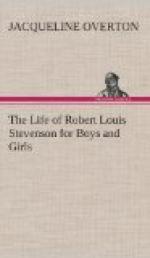So he purchased four hundred acres on the hills three miles from Apia and preparations were immediately made for clearing the ground and building a house. Lloyd Osbourne left for England to bring back the household treasures from Skerryvore, to make a real home, and Stevenson and his wife lived gypsy fashion meanwhile in a four-room wooden house.
The new home was named Vailima, which is Samoan for “Five Waters,” there being five streams running through the property.
The house was built of wood, painted dark green with a red roof. When finished its chief feature was the great hall within, sixty feet long, lined and ceiled with California redwood. Here among the home treasures—his own portrait, war dresses, corselets, fans, and mats presented to him by island kings—the marble bust of grandfather Stevenson smiled down with approval on many a motley gathering. Louis often wondered if they reminded the old gentleman of some of the strange people he had entertained years ago in Baxter Place.
All about was dense, tropical undergrowth, only paths led to the house, and these must continually be cut out. All carrying was done by two big New Zealand pack-horses.
A large garden was planted—Mrs. Stevenson’s special hobby. Cocoanuts, oranges, guavas, and mangoes already grew on the estate. The ground was very fertile, and kava, the root of which is used for the Samoan national drink, pineapples, sweet potatoes, and eggplants were soon flourishing among other things. Limes were so plentiful that they formed the hedge about the place; citrons were so common that they rotted on the trees.
[Illustration: The house at Vailima]
All this ground-breaking, house-building, and gardening were new to Stevenson, and he revelled in them to the neglect of his writing.
“This is a hard and interesting and beautiful life we lead now,” he wrote to Sidney Colvin. “Our place is in a deep cleft of Vaea Mountain; some six hundred feet above the sea, embowered in forest, which is our strangling enemy, and which we combat with axes and dollars. I am crazy over outdoor work, and had at last to confine myself to the house, or literature must have gone by the board. Nothing is so interesting as weeding, clearing, and pathmaking; the oversight of laborers becomes a disease; it is quite an effort not to drop into the farmer; and it does make you feel so well. To come down covered with mud and drenched with sweat and rain after some hours in the bush, change, rub down, and take a chair in the verandah, is to taste a quiet conscience.”
Before his arrival in Apia, Stevenson’s tale of “The Bottle Imp” had been translated into Samoan by the missionaries. When the natives discovered he was its author they immediately named him Tusitala, The Teller-of-Tales. He still owned the bottle, they said; it was that gave him the wealth to cruise about in a great boat and build a fine house. The family often wondered why native visitors were curious to see the inside of the great safe in the hall at Vailima until they found that it was the belief among the islanders that the safe was the bottle’s hiding-place.




